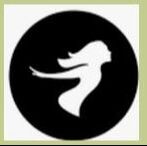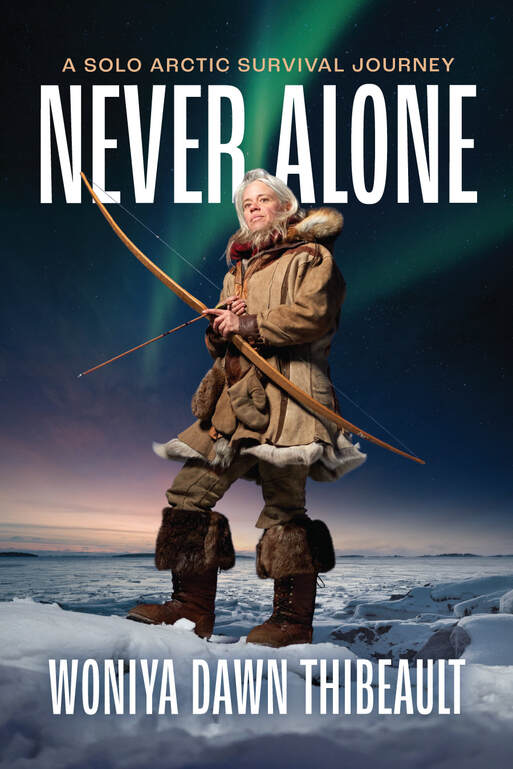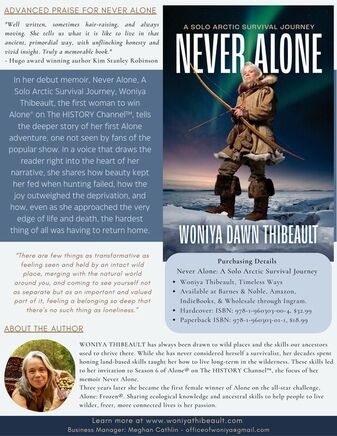Section divider type: wavesOpacity --
position: top
NEVER ALONE: A Solo Arctic Survival Journey
Never Alone is now out..

And people are loving it!
Best seller status with 5 out of 5 stars in its first week of release!
See information below to order your copy
Best seller status with 5 out of 5 stars in its first week of release!
See information below to order your copy
Physical Copies
International Copies and Ebooks
Check the tour schedule to see if Woniya will be doing a book signing near you!
"Well written, sometimes hair raising, and always moving... with unfliching honesty and vivid insight. Truly a memorable book."
-Hugo award winning author, Kim Stanley Robinson
In Woniya's debut memoir about her experience on Season 6 of the HISTORY Channel's hit survival show Alone®, she shares the deeper story, not seen by its viewers. She illustrates how the beauty kept her fed when hunting failed, how the magic she experienced outweighed the challenges, and months of living solo in the Arctic Wilderness brought
more healing that suffering.
Never Alone, told mostly in first-person, present-tense draws the reader right into the story to experience the pain and deprivation as well as the beauty and wonder. Its message
is one of inspiration and learning to trust in ourselves and the land around us—embracing the wild and being wholly and beautifully human, flaws and all.
more healing that suffering.
Never Alone, told mostly in first-person, present-tense draws the reader right into the story to experience the pain and deprivation as well as the beauty and wonder. Its message
is one of inspiration and learning to trust in ourselves and the land around us—embracing the wild and being wholly and beautifully human, flaws and all.
Help out by asking your local bookstore to carry Never Alone!
Click the icon on the right to download and share the order info with them
| |||||||
Section divider type: triangleAsym --
position: bottom
Excerpt from Chapter 1 of Never Alone
I heave a deep sigh and watch the water vapor from my breath—a small white cloud against the backdrop of heavy, dark clouds—float out across the ice. It makes it about ten feet before freezing solid and drifting down to the lake’s surface.
The cramping of my shrunken stomach has become such a fixture in my world that I barely register it anymore. This time as it twists inside me, I’m deeply aware of the ache and how long it’s been since I had anything to fill that empty hollow.
I ventured onto the frozen lake tonight to hunt, only to discover the game I was after was far out of my reach. But that wasn’t my only motivation. The Arctic has taught me I can be fed by more than just food—beauty, adventure, and wildness are powerful sustenance as well.
An island blocks my view to the west, so I can’t tell if the sun has dipped beneath the horizon yet, but I know it must be nearly down. At this latitude, just south of the Arctic Circle, there are about four hours of solid daylight this time of year, with another hour of hazy, low light at dawn and dusk. The smart choice would be to turn around and head back to the cabin, get the fire going, and make another pot of the coffee-colored chaga tea that serves for dinner (and breakfast, and lunch) these days. I know that. My body may be failing, but my reason is still intact. I know too that once the sun goes down, the temperature out on the ice is going to plummet.
Back toward camp and safety, or the open lake ice and adventure—what’s it going to be?
I cup my palms to catch my warm breath and direct it over my cheeks until I can feel them again. I give my rabbit fur scarf a quarter turn to find a spot for my face that isn’t crusted with my frozen breath, turn away from the island—and my little arctic home on the peninsula beyond it—and head out across the lake.
Not all the way, I promise myself, as I head directly away from the small peninsula in the wilderness where I’ve been making my home for the past two and a half months.
I’m almost to the shore when I see something weird happening with the surface of the ice ahead of me. What has been flat white as far as the eye can see is now bumpy and ridged. The strange bumps aren’t white like the rest of the ice, they’re marbled with brown swirls. What the heck?
I turn around to check the light and judge how much time I’ve got. My impulsiveness is starting to catch up with me. I can feel the fatigue in my legs and the effort it’s taken them to carry me here. This is too damn far from home for this hour of night, but I’m intrigued, and it’ll only take me a minute to explore this new mystery. A minute more isn’t going to make a difference in the light.
I creep cautiously toward the bumps, and I’m only a few steps from the closest one when I freeze.
It takes me a second to register what I’m sensing. I hear something. In all this vast, frozen wilderness there has been almost no sound for hours, except for the high-pitched calls of one chickadee on the island, and my own breath in my ears. This is totally different. Faint, low, and ever-changing. There’s something familiar about it—something I know but can’t quite place. And then I’m hot all over, my chest tight against the furs of my parka—my body registering what it is a second before my brain does.
It’s gurgling. I look down at the ice below my feet. There, not far beneath my toes, I see an amoeboid white shape fly past under the ice, and then another. Air bubbles. My heartbeat thuds in my ears. Suddenly it all makes sense.
The shape of the land in front of me—a narrow valley pointing right toward the lake.
The irregular shapes on the lake surface.
The roar of sound I heard so often out of the north before freeze-up.
Not wind through the trees as I’d imagined, but a wide and rushing river, loud enough to hear from all the way back at the peninsula. The strange shapes are foamy water and standing waves frozen in place, the brown swirls are the muddy water they carry. I’m not standing on the lake anymore; I’m standing on top of an enormous, fast-moving river, and the ice beneath me is only inches thick.
Adrenaline clouds my thinking like the descending darkness clouds my vision. Months of careful risk avoidance while living on my own in one of the wildest, most remote places on earth amidst wolverines and wolf packs, and never a second of serious danger or deep, visceral fear. Now, in one foolish moment, I’ve hiked myself smack on top of the biggest hazard imaginable.
I take a few deep breaths to choke down my panic. Ice over moving water is soft and weak, full of air and irregularities. One wrong step and I could go down in a heartbeat, sucked under the lake’s surface by the flowing current. It’s already too dark for the rescue helicopter to fly. Even if it could, if I go through the ice and manage to stay on the surface, the crew would never get to me before the hypothermia does.
Think Woniya, think...
I heave a deep sigh and watch the water vapor from my breath—a small white cloud against the backdrop of heavy, dark clouds—float out across the ice. It makes it about ten feet before freezing solid and drifting down to the lake’s surface.
The cramping of my shrunken stomach has become such a fixture in my world that I barely register it anymore. This time as it twists inside me, I’m deeply aware of the ache and how long it’s been since I had anything to fill that empty hollow.
I ventured onto the frozen lake tonight to hunt, only to discover the game I was after was far out of my reach. But that wasn’t my only motivation. The Arctic has taught me I can be fed by more than just food—beauty, adventure, and wildness are powerful sustenance as well.
An island blocks my view to the west, so I can’t tell if the sun has dipped beneath the horizon yet, but I know it must be nearly down. At this latitude, just south of the Arctic Circle, there are about four hours of solid daylight this time of year, with another hour of hazy, low light at dawn and dusk. The smart choice would be to turn around and head back to the cabin, get the fire going, and make another pot of the coffee-colored chaga tea that serves for dinner (and breakfast, and lunch) these days. I know that. My body may be failing, but my reason is still intact. I know too that once the sun goes down, the temperature out on the ice is going to plummet.
Back toward camp and safety, or the open lake ice and adventure—what’s it going to be?
I cup my palms to catch my warm breath and direct it over my cheeks until I can feel them again. I give my rabbit fur scarf a quarter turn to find a spot for my face that isn’t crusted with my frozen breath, turn away from the island—and my little arctic home on the peninsula beyond it—and head out across the lake.
Not all the way, I promise myself, as I head directly away from the small peninsula in the wilderness where I’ve been making my home for the past two and a half months.
I’m almost to the shore when I see something weird happening with the surface of the ice ahead of me. What has been flat white as far as the eye can see is now bumpy and ridged. The strange bumps aren’t white like the rest of the ice, they’re marbled with brown swirls. What the heck?
I turn around to check the light and judge how much time I’ve got. My impulsiveness is starting to catch up with me. I can feel the fatigue in my legs and the effort it’s taken them to carry me here. This is too damn far from home for this hour of night, but I’m intrigued, and it’ll only take me a minute to explore this new mystery. A minute more isn’t going to make a difference in the light.
I creep cautiously toward the bumps, and I’m only a few steps from the closest one when I freeze.
It takes me a second to register what I’m sensing. I hear something. In all this vast, frozen wilderness there has been almost no sound for hours, except for the high-pitched calls of one chickadee on the island, and my own breath in my ears. This is totally different. Faint, low, and ever-changing. There’s something familiar about it—something I know but can’t quite place. And then I’m hot all over, my chest tight against the furs of my parka—my body registering what it is a second before my brain does.
It’s gurgling. I look down at the ice below my feet. There, not far beneath my toes, I see an amoeboid white shape fly past under the ice, and then another. Air bubbles. My heartbeat thuds in my ears. Suddenly it all makes sense.
The shape of the land in front of me—a narrow valley pointing right toward the lake.
The irregular shapes on the lake surface.
The roar of sound I heard so often out of the north before freeze-up.
Not wind through the trees as I’d imagined, but a wide and rushing river, loud enough to hear from all the way back at the peninsula. The strange shapes are foamy water and standing waves frozen in place, the brown swirls are the muddy water they carry. I’m not standing on the lake anymore; I’m standing on top of an enormous, fast-moving river, and the ice beneath me is only inches thick.
Adrenaline clouds my thinking like the descending darkness clouds my vision. Months of careful risk avoidance while living on my own in one of the wildest, most remote places on earth amidst wolverines and wolf packs, and never a second of serious danger or deep, visceral fear. Now, in one foolish moment, I’ve hiked myself smack on top of the biggest hazard imaginable.
I take a few deep breaths to choke down my panic. Ice over moving water is soft and weak, full of air and irregularities. One wrong step and I could go down in a heartbeat, sucked under the lake’s surface by the flowing current. It’s already too dark for the rescue helicopter to fly. Even if it could, if I go through the ice and manage to stay on the surface, the crew would never get to me before the hypothermia does.
Think Woniya, think...
Want more? Enter your information to preview the first 3 chapters here!
Quotes from Never Alone:
“There are few things as transformative as feeling seen and held by an intact wild place, merging with the natural world around you, and coming to see yourself not as separate but as an important and valued part of it, feeling a belonging so deep that there’s no such thing as
loneliness.”
“I came here to lay myself on the altar of wildness—to surrender to the deep wisdom of the land around me."
“How do you return to the human-create world, when you’ve known what it is to live in the wild like a creature that belongs there and is part of it?"
“In the arms of that benevolent wilderness and the life-altering process of integrating the wisdom it gave me, I was finally able to shrug off the caterpillar form of the girl who never quite believed in herself, unfurl the colorful wings of a stronger, wiser, more confident woman, and fly."
“There are few things as transformative as feeling seen and held by an intact wild place, merging with the natural world around you, and coming to see yourself not as separate but as an important and valued part of it, feeling a belonging so deep that there’s no such thing as
loneliness.”
“I came here to lay myself on the altar of wildness—to surrender to the deep wisdom of the land around me."
“How do you return to the human-create world, when you’ve known what it is to live in the wild like a creature that belongs there and is part of it?"
“In the arms of that benevolent wilderness and the life-altering process of integrating the wisdom it gave me, I was finally able to shrug off the caterpillar form of the girl who never quite believed in herself, unfurl the colorful wings of a stronger, wiser, more confident woman, and fly."

About the Author
Woniya Thibeault never felt at home in the modern world. As a lonely only child, she always found comfort and companionship in nature. By the time she was 19, she was not only studying biology and environmental studies, she was also throwing herself into mastering the skills our ancestors used to thrive in the wild—foraging for food, skinning animals and tanning their hides for clothing, weaving baskets from wild
harvested willow, and making her own bows and arrows. Before long she was making a name for herself as an instructor of many of these skills. Even so, she was shocked when The HISTORY Channel’s hit survival TV show Alone® came calling and invited her to be a participant on Season 6. Never Alone is the story of that journey.
Three years after the solo challenge seen on Season 6 of the Alone® series on The HISTORY Channel™, Woniya was invited to compete in an even more rugged spin-off series, Alone®: Frozen, where she made history. Across her two stints in the wild, she set a new record for cumulative days on an Alone® solitary wilderness survival challenge and also became the first woman to win one. Another memoir, about that journey, is in the works.
Help us promote Never Alone
The deeper themes of Never Alone- those of connection instead of competition, reciprocity instead of domination, and gratitude instead of entitlement, are particularly needed in today's modern, industrialized world. If you agree and would like to help get Never Alone into as many hands as possible, there are a lot of ways you can help!
Ask your local book stores and libraries to carry Never Alone, order a copy or several copies and share them with your friends and loved ones. Ask your local paper to do a piece about it, leave reviews of it on Amazon or your favorite online retailer.
Download and share our promo kit for local press here: Download and share the sell sheet for your local bookstore here:
Ask your local book stores and libraries to carry Never Alone, order a copy or several copies and share them with your friends and loved ones. Ask your local paper to do a piece about it, leave reviews of it on Amazon or your favorite online retailer.
Download and share our promo kit for local press here: Download and share the sell sheet for your local bookstore here:
|
| ||||||||||||
Woniya ThibeaultBased in the beautiful Sierra Nevada Mountains, Woniya pops back and forth between the eastern slopes near Reno, Nevada and the western slopes in Nevada County, California.
Teaching and speaking across the USA and virtually around the world.
|
© 2022 All rights reserved.













